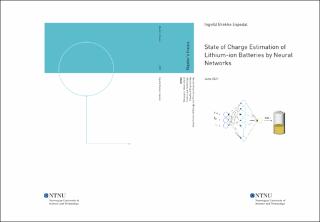State of Charge Estimation of Lithium-ion Batteries by Neural Networks
Master thesis
Permanent lenke
https://hdl.handle.net/11250/2789450Utgivelsesdato
2021Metadata
Vis full innførselSamlinger
Sammendrag
Formålet med denne avhandlingen er å estimere ladetilstanden til litium-ionbatterier i elektriskebiler. Ved bruk av nevrale nettverk undersøkes maskinlæringsteknikker og inputvariabler for åøke nøyaktigheten på estimert ladetilstand. Dette målet grunner i et underliggende krav for åadministrere energisystemet til elektriske kjøretøy i sanntid. Fagområdets hovedutfordring er atladetilstanden ikke kan måles direkte. Videre er estimering av ladetilstanden et ulineært problemsom avhenger av flere variabler som omgivelsestemperatur, spenning, trukket strøm, aldring ogcellekjemi. Maskinlæring kan være et kraftig verktøy for å transformere inputvariabler til outputvariablerved komplekse problemstillinger og kan brukes til å forbedre estimeringen av ladetilstanden tillitiumionbatterier.
Denne rapporten er en kritisk analyse av tidligere arbeid hvor maskinlæring har blitt brukttil å transformere fysiske batterivariabler til batteriets ladetilstand. I tillegg er forovermatedenevrale nettverk konstruert for å undersøke forskjellige teknikker og inngangsfunksjoner for åforbedre estimeringsnøyaktigheten. Resultatene indikerer at nevrale nettverkstilnærminger kanvære tilstrekkelig for å estimere ladetilstand med en kvadratisk gjennomsnittlig feil på rundt enprosent. Et viktig funn er at estimeringsfeilen for ladetilstand ble lavere ved å bruke akkumulertvarme fra batteriet som en ekstra inputvariabel i tillegg til de klassiske inputvariablene spenning,strøm og batteritemperatur. Med den nye variabelen ble den største feilen redusert med 27% frareferansemodellen. Den maksimale feilen var imidlertid 6% ladetilstand, som er for høyt for en elbil. Feilen måreduseres for at det forovermatede nevrale netverket skal kunne brukes i praksis. Den overordnedekonklusjonen er at nevrale nettverk har potensiale til å bli brukt til å estimere ladetilstanden tilelektriske kjøretøy. Imidlertid kreves det videre arbeid for å koble sammen elektriske, termiskeog mekaniske egenskaper for å sikre et robust estimat for ladetilstanden under ulike fohold. By using neural networks, this thesis examines machine learning techniques and input featuresto increase the accuracy of State of Charge (SoC) estimation of lithium-ion batteries of electricvehicles. The aim to estimate the SoC with high accuracy is an underlying requirement to managethe energy system of electrical vehicles in real-time. The main challenge in this field is that theSoC cannot be measured directly. Furthermore, estimating the SoC is a nonlinear problem dependenton numerous variables including ambient temperature, heat generation, voltage, currentdrawn, aging, and cell chemistry. Machine learning can be a powerful tool to map input variablesonto output variable(s) for complex problems and can be used to improve the SoC estimation inlithium-ion batteries.
This thesis contains a critical survey of previous work that utilizes machine learning to mapphysical battery variables into the SoC. In addition, neural networks have been constructedto research different techniques and input features to improve estimation accuracy. The resultsindicate that neural network approaches can be adequate when estimating the SoC, where theroot mean squared error is around one percent. An important finding of this thesis is the effectof using the accumulated heat from the battery as an additional input feature in addition to theclassical input features voltage, current, and battery temperature. With this new feature, theerror was reduced by 27% from the benchmark case. However, the maximum obtained error was6% SoC which is inconvenient in an electric car. This has to be reduced for the model to be usedin a real-world application. The overall conclusion is that neural networks have the potential tobe used as the SoC estimator in electrical vehicles. However, further work to couple electrical,thermal, and mechanical properties are required to ensure their robustness.
